Spatial awareness Normal Space Worksheets for Ages 3-7
3 filtered results
-
From - To
Introduce your young learners to the fascinating world of spatial awareness with our engaging Normal Space Worksheets for ages 3-7. Designed to develop crucial spatial skills, these worksheets help children understand position, direction, and distance. Each activity offers an exciting way to enhance their cognitive and problem-solving abilities through fun, interactive exercises. Brightly illustrated and captivating, our worksheets make learning a delightful adventure, ensuring kids grasp essential spatial concepts early on. Perfect for home or classroom use, these tools are a must-have for fostering early STEM skills and confidence in young explorers!


The Night Sky: Leo Worksheet


Spaceship Maze: Galaxies Worksheet


Astronomer Maze: Telescope Worksheet
Spatial awareness is a critical aspect of early childhood development, and parents and teachers should prioritize it for children aged 3-7. At this stage, kids begin to explore and understand the environment around them, which fuels their overall cognitive, physical, and social growth.
Developing spatial awareness helps children learn how to navigate spaces safely and efficiently, reducing the risk of accidents. It also lays the foundation for essential life skills like coordination and balance, which are vital for daily activities and physical play. These skills become crucial for more complex tasks, such as riding a bike and playing sports.
Cognitively, spatial awareness boosts problem-solving abilities and fosters creativity. Understanding spatial relationships like "above," "below," "near," and "far" is vital for math and reading readiness—skills that are directly linked to academic achievement. Being cognizant of where objects are in relation to one another aids in better comprehension of math concepts such as geometry, measurement, and mapping.
Socially, spatial awareness encourages cooperative play and teamwork, as children learn to judge personal space while interacting with peers. This understanding helps them to engage in group activities more effectively and enjoy positive social experiences.
In summary, prioritizing spatial awareness in early childhood sets the groundwork for children's physical safety, cognitive development, and social interaction, contributing to a well-rounded growth trajectory.
 Assign to My Students
Assign to My Students














